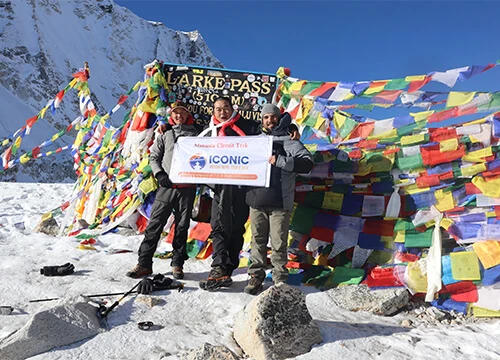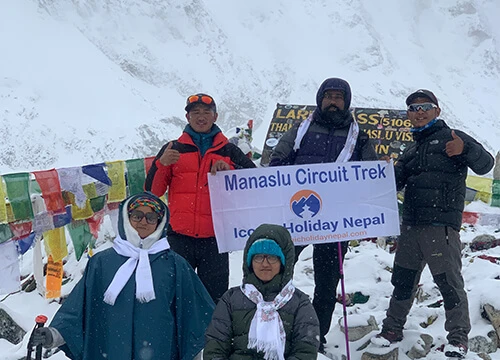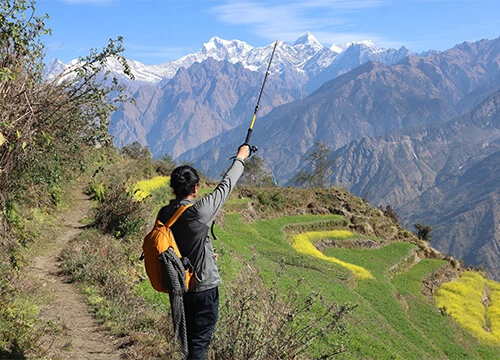Manaslu Region Trek
Manaslu Region is widely known for encompassing the world's eighth-highest mountain, Mt. Manaslu (8,163m). Lying in the east of Annapurna in the Gorkha district of Nepal, the Manaslu Region offers many peaks over 6,500 meters in height. You will trek in the Manaslu Conservation Area, a restricted area where solo trekking is not allowed. The region inhibits some of the endangered flora and fauna. The main trekking trail of the Manaslu Region passes through the gorge and banks of the Budhi Gandaki River.
Popular Treks
Manaslu Circuit Trek and Manaslu Tsum Valley Trek
Major Attractions
Explore the Manaslu Base Camp, Larkya La Pass, Birendra Lake, ancient monasteries (Mu Gompa, Rachen Gompa), green meadows, Tibetan Buddhist cultural heritage, Tusm Valley, glaciers, etc. Witness snow-covered mountains of the Manaslu Region, such as Ganesh Himal, Himalchuli, Tsum Valley, Cheo Himal, and many others.
Best Time
The most ideal time to explore the Manaslu Region is during spring (March, April and May) and autumn (September, October and November), when the view is clearest and mesmerizing. These two seasons have the best weather and climate.
Food and Accommodation
Teahouse trek. The tea houses are basic accommodation run by the locals. Limited services with shared rooms and washrooms are available. Tibetan and Nepali dishes are mostly available on the menu. Dal bhat is a super meal with other options like thukpa, Tibetan bread, toast, soup, etc.
Permits Required
To undertake the Manaslu Circuit Trek, which includes Tsum Valley, you'll need four permits: the Manaslu Restricted Area Permit (Manaslu RAP) for the core trek, the Annapurna Conservation Area Permit (ACAP Permit) for a section of the journey, and the Manaslu Conservation Area Project Permit (MCAP Permit) for another portion. If you plan to explore the captivating Tsum Valley, a separate Tsum Valley Permit is also required. These permits are essential for regulating access, preserving nature, and supporting local communities in these regions of Nepal. For more information please click Trekking Permit
Restricted Area Permit for Tsum Valley
Tsum Valley is classified as a restricted area because it is located close to the Tibetan border. For border security reasons, control of tourism and other activities, and protection of the culture and landscape, it is designated a restricted area by the government of Nepal.
Permit Cost (Issued by Department of Immigration, Nepal):
- September to November (Autumn Season) is US$ 40 for the first week and then US$ 7 for each additional day spent in the restricted area.
- December to August (Winter, Spring, and Summer Seasons) is US$ 30 for the first week, and then US$ 7 for each additional day spent in the restricted area.
Special Restricted Area Permit for Manaslu (Manaslu RAP):
This permit is required from Jagat until you reach Sama-Gaun. Once you pass through Sama, you'll need another entry permit (ACAP). The cost of the Manaslu RAP depends on the duration of your stay between Jagat and Dharapani. The final checkpoint for the RAP is located in Sama Gaun.
Permit Costs:
- September to November: USD 100 per person for the first seven days, with an additional USD 15 per person per day from the eighth day onwards.
- December to August: USD 75 per person for the first seven days, with an additional USD 10 per person per day from the eighth day onwards.
Manaslu Conservation Area Project (MCAP Permit):
This permit is necessary from Philim, which marks the beginning of the Manaslu Conservation Area. The permit fees support the development and protection of the Manaslu conservation area, which encompasses an area of 1,663 sq. km
Permit Cost:
- Fee for SAARC nationals is NRs. 1000 per person (US$ 10 approx.)
- The fee for other nationals is NRs. 3000 per person (US$ 30 approx.
Annapurna Conservation Area Project (ACAP Permit):
ACAP is an Annapurna Conservation Area Permit that allows you to enter the Annapurna Conservation Area. You'll need this permit from Dharapani until you exit ACAP in Beshi Sahar. The cost is consistent year-round. Similar to MCAP, there are no restrictions or price changes based on the duration of your stay inside ACAP. It's important to note that a printed photograph is required for the ACAP permit.
Permit Cost:
- ACAP for SAARC Nationals: 10 USD i.e. NPR 1000 per pax.
- ACAP for Non-SAARC nationals: 30 USD i.e. NPR 3000 per pax.
Once you have obtained the RAP and both conservation area entry permits, there is no need to acquire a TIMS (Trekkers Information Management System) card



